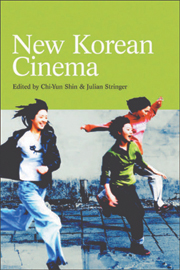Book contents
- Frontmatter
- Contents
- Notes on the Contributors
- List of Illustrations
- Introduction
- Part I Forging a New Cinema
- Part II Generic Transformations
- Part III Social Change and Civil Society
- 11 Peppermint Candy: The Will Not to Forget
- 12 The Awkward Traveller in Turning Gate
- 13 Memento Mori and Other Ghostly Sexualities
- 14 Interethnic Romance and Political Reconciliation in Asako in Ruby Shoes
- Glossary of Key Terms
- Bibliography of Works on Korean Cinema
- Websites
- Index
14 - Interethnic Romance and Political Reconciliation in Asako in Ruby Shoes
from Part III - Social Change and Civil Society
Published online by Cambridge University Press: 05 August 2013
- Frontmatter
- Contents
- Notes on the Contributors
- List of Illustrations
- Introduction
- Part I Forging a New Cinema
- Part II Generic Transformations
- Part III Social Change and Civil Society
- 11 Peppermint Candy: The Will Not to Forget
- 12 The Awkward Traveller in Turning Gate
- 13 Memento Mori and Other Ghostly Sexualities
- 14 Interethnic Romance and Political Reconciliation in Asako in Ruby Shoes
- Glossary of Key Terms
- Bibliography of Works on Korean Cinema
- Websites
- Index
Summary
‘Home’ has become such a scattered, damaged, various concept in our present travails. There is so much to yearn for. There are so few rainbows any more. How hard can we expect even a pair of magic shoes to work? They promised to take us home, but are metaphors of homeliness comprehensible to them?
(Salman Rushdie, ‘At the Auction of the Ruby Slippers’)The above words – drawn from Salman Rushdie's short story about the famous footwear worn by Judy Garland in The Wizard of Oz (US, 1939) – find the author in a reflective mood. No stranger to the kind of emotional upheaval and cultural displacement literally ‘weathered’ by Dorothy in her picaresque rite of passage from sepia-toned Kansas to kaleidoscopic Oz, Rushdie slips from reverie to rhetorical yearning, and evokes – in his description of a ‘scattered’ and ‘damaged’ home – a sentiment that has become increasingly salient in South Korean cinema. It should come as no surprise that this Holy Grail of movie memorabilia, this fetishised pair of magic slippers which first enticed the exiled writer as a young boy in Bombay, emblematically figures in a millennial film that similarly revolves around departure and return, migration and habitation. As suggested by its English-language title, Asako in Ruby Shoes (Sunaebo, 2000) is a ‘hymn … to Elsewhere’, one that plunders the iconography of a Hollywood classic so as to reformulate such perennial themes as alienation, desire and boredom in the context of another geospatial imaginary.
- Type
- Chapter
- Information
- New Korean Cinema , pp. 193 - 209Publisher: Edinburgh University PressPrint publication year: 2005



